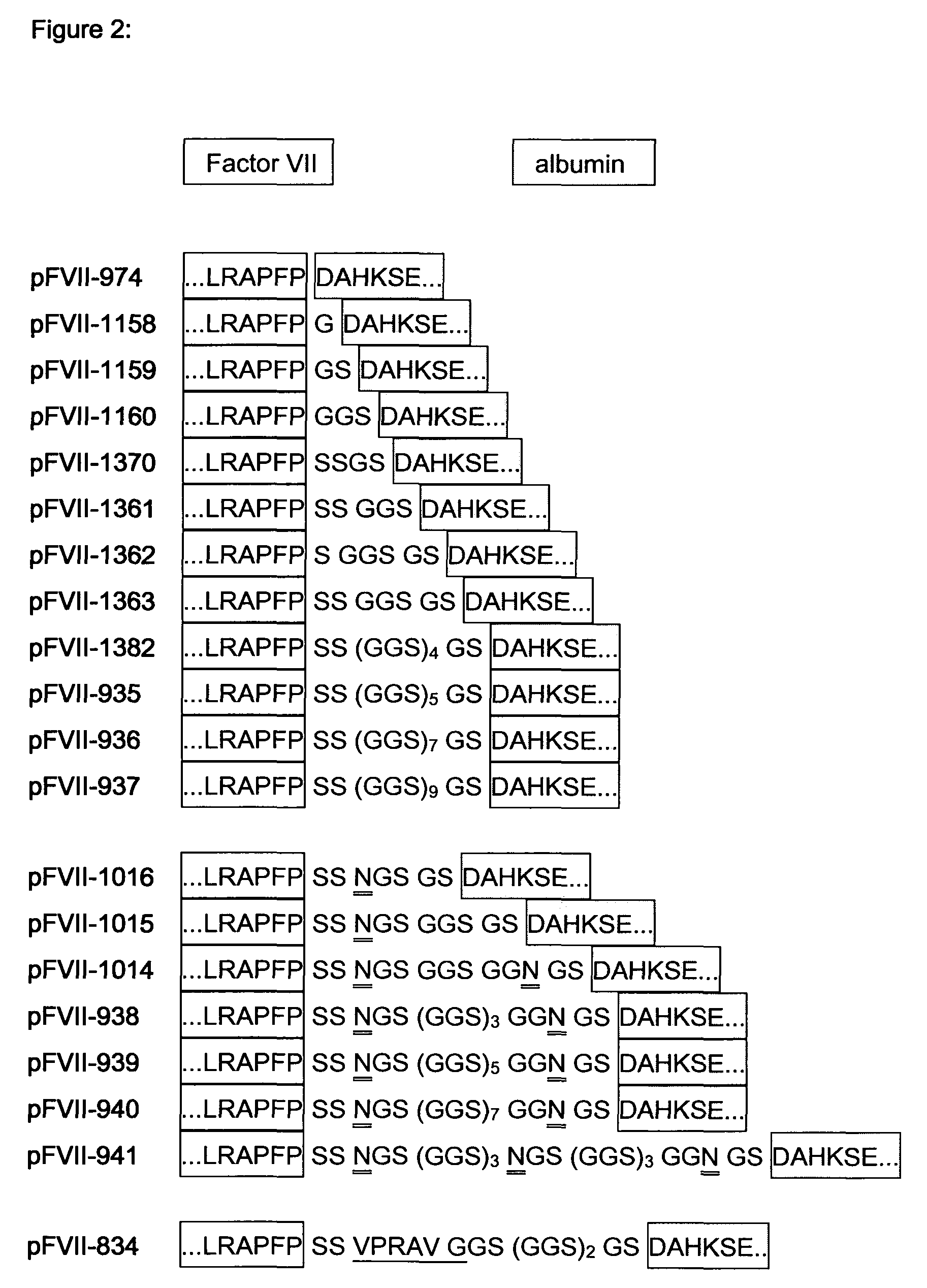Modified Coagulation Factor VIIa With Extended Half-Life
- Summary
- Abstract
- Description
- Claims
- Application Information
AI Technical Summary
Benefits of technology
Problems solved by technology
Method used
Image
Examples
example 1
Generation of cDNAs Encoding FVII—Albumin Fusion Polypeptides
[0103]Factor VII coding sequence was amplified by PCR from a human liver cDNA library (ProQuest, Invitrogen) using primers We1303 and We1304 (SEQ ID NO 1 and 2). After a second round of PCR using primers We1286 and We 1287 (SEQ ID NO 3 and 4) the resulting fragment was cloned into pCR4TOPO (Invitrogen). From there the FVII cDNA was transferred as an EcoRI Fragment into the EcoRI site of pIRESpuro3 (BD Biosciences) wherein an internal XhoI site had been deleted previously. The resulting plasmid was designated pFVII-659.
[0104]Subsequently an XhoI restriction site was introduced into pFVII-659 at the site of the natural FVII stop codon (FIG. 1) by site directed mutagenesis according to standard protocols (QuickChange XL Site Directed Mutagenesis Kit, Stratagene) using oligonucleotides We1643 and We 1644 (SEQ ID NO 5 and 6). The resulting plasmid was designated pFVII-700.
[0105]Oligonucleotides We 1731 and We1732 (SEQ ID NO 7 a...
example 2
Transfection and Expression of Factor VII—Albumin Fusion Polypeptides
[0112]Plasmids were grown up in E. coli TOP10 (Invitrogen) and purified using standard protocols (Qiagen). HEK-293 cells were transfected using the Lipofectamine 2000 reagent (Invitrogen) and grown up in serum-free medium (Invitrogen 293 Express) in the presence of 50 ng / ml Vitamin K and 4 μg / ml Puromycin. Transfected cell populations were spread through T-flasks into roller bottles from which supernatant was harvested for purification.
example 3
Purification of FVII and FVII—Albumin Fusion Polypeptides
[0113]Cell culture harvest containing FVII or FVII albumin fusion protein was applied on a 2.06 mL Q-Sepharose FF column previously equilibrated with 20 mM HEPES buffer pH 7.4. Subsequently, the column was washed with 10 volumes of the named HEPES buffer. Elution of the bound FVII molecules was achieved by running a linear gradient from 0 to 1.0 M NaCl in 20 mM HEPES buffer within 20 column volumes. The eluate contained about 85-90% of the applied FVII antigen at protein concentrations between 0.5 and 1 g / L.
[0114]Alternatively FVII was purified by chromatography using immobilized tissue factor as described in EP 0770625B1.
[0115]FVII antigen and activity were determined as described in example 4.
PUM
| Property | Measurement | Unit |
|---|---|---|
| Fraction | aaaaa | aaaaa |
| Fraction | aaaaa | aaaaa |
| Composition | aaaaa | aaaaa |
Abstract
Description
Claims
Application Information
 Login to View More
Login to View More - R&D
- Intellectual Property
- Life Sciences
- Materials
- Tech Scout
- Unparalleled Data Quality
- Higher Quality Content
- 60% Fewer Hallucinations
Browse by: Latest US Patents, China's latest patents, Technical Efficacy Thesaurus, Application Domain, Technology Topic, Popular Technical Reports.
© 2025 PatSnap. All rights reserved.Legal|Privacy policy|Modern Slavery Act Transparency Statement|Sitemap|About US| Contact US: help@patsnap.com



